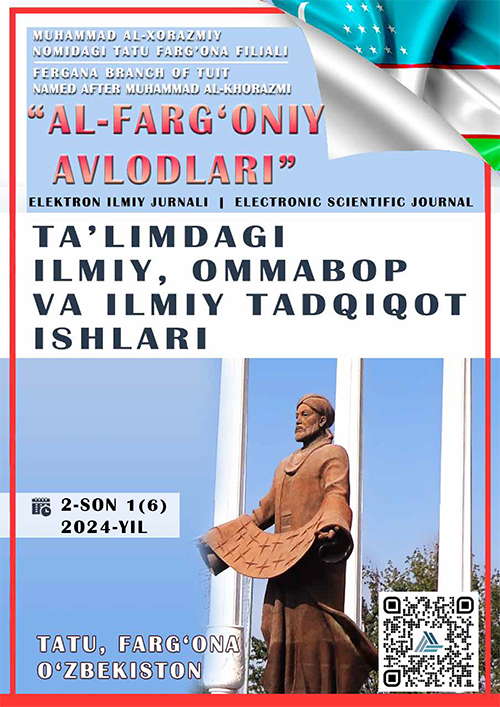LEARNING THE USE OF MODERN MODELS AND ALGORITHMS IN THE ANALYSIS OF HUMAN BODY MOVEMENTS
Keywords:
Kalit so‘zlar: Inson harakatini tahlil qilish, Harakatni suratga olish, Pozani baholash, Harakatni aniqlash, Imo-ishoralarni tushunish, Inson va kompyuter o‘zaro ta’siri (HCI), Kompyuterni ko‘rish, Mashinani o‘rganish, Sun’iy intellekt (AI), Ehtimoliy grafik modellar (PGM), Yashirin Markov modellari ( HMM), Shartli tasodifiy maydonlar (CRF), Uzoq qisqa muddatli xotira tarmoqlari (LSTM), Konvolyutsion neyron tarmoqlari (CNN), Chuqur o‘rganish, Generativ modellar, Xususiyatlarni ajratib olish, Tasniflash, Regressiya, Klasterlash.Abstract
Annotation: Human movement analysis is the study and construction of models that involve understanding the movement of the human body. It serves to develop various fields such as sports, healthcare, robotics and animation. By analyzing human movement, we can gain valuable insights into biomechanics, improve performance, and identify abnormalities. In this article, we will look at the various models and algorithms used in human behavior analysis.
References
Liangchen Song, Gang Yu, Junsong Yuan, Zicheng Liu “Human pose estimation and its application to action recognition: A survey”. Journal of Visual Communication and Image Representation Volume 76, April 2021
Zhaozong Meng, Mingxing Zhang, Changxin Guo, Qirui Fan, Hao Zhang, Nan Gao, Zonghua Zhang “Recent Progress in Sensing and Computing Techniques for Human Activity Recognition and Motion Analysis”. Electronics 2020
Hao, Z., Niu, J., Dang, X., and Qiao, Z. (2022). WiPg: contactless action recognition using ambient wi-fi signals. Sensors. 22, 402. doi: 10.3390/s22010402
Dong, B., Zhang, Z., Shi, Q., Wei, J., Ma, Y., and Xiao, Z. (2022). Biometrics-protected optical communication enabled by deep learning–enhanced triboelectric/photonic synergistic interface. Sci. Adv. 8, eabl9874. doi: 10.1126/sciadv.abl9874
Kang, S., Jang, M., and Lee, S. (2021). Identification of human motion using radar sensor in an indoor environment. Sensors. 21, 2305. doi: 10.3390/s21072305
Sedmidubsky, J., Elias, P., Budikova, P., and Zezula, P. (2021). Content-based management of human motion data: survey and challenges. IEEE Access. 9, 64241–64255. doi: 10.1109/ACCESS.2021.3075766
Sarma, M. S., Deb, K., Dhar, P. K., and Koshiba, T. (2021). Traditional Bangladeshi sports video classification using deep learning method. Appl. Sci. 11, 2149. doi: 10.3390/app11052149
Liu, Y., and Ji, Y. (2021). Target recognition of sport athletes based on deep learning and convolutional neural network. J. Intellig. Fuzzy Syst. 40, 2253–2263. doi: 10.3233/JIFS-189223
S. Kettebekov, R. Sharma. “Understanding gestures in multimodal human computer interaction”. International Journal on Artificial Intelligence ToolsVol. 09, No. 02, pp. 205-223 (2000)
G. Panahandeh, N. Mohammadiha, A. Leijon and P. Händel, "Continuous Hidden Markov Model for Pedestrian Activity Classification and Gait Analysis," in IEEE Transactions on Instrumentation and Measurement, vol. 62, no. 5, pp. 1073-1083, May 2013, doi: 10.1109/TIM.2012.2236792
Behrooz Mahasseni, Sinisa Todorovic. “Regularizing Long Short Term Memory With 3D Human-Skeleton Sequences for Action Recognition”. Proceedings of the IEEE Conference on Computer Vision and Pattern Recognition (CVPR), 2016, pp. 3054-3062
Imed Bouchrika, Mark S. Nixon. “Model-Based Feature Extraction for Gait Analysis and Recognition” Computer Vision/Computer Graphics Collaboration Techniques, 2007, Volume 4418. ISBN : 978-3-540-71456-9
Lorena Gril, Philipp Wedenig, Chris Torkar, Ulrike Kleb. “A Tensor-based Regression Approach for Human Motion Prediction”. Special Issue:THE ENBIS‐21 QUALITY AND RELIABILITY ENGINEERING INTERNATIONAL. Volume39, Issue2. March 2023. Pages 481-499
KURBANOV A.A. Multimodal emotion recognition: a comprehensive survey with deep learning. Journal of Research and Innovation, pp. 43-47. 2023
Kurbanov Abdurahmon Alishboyevich. A Methodological Approach to Understanding Emotional States Using Textual Data. Journal of Universal Science Research. 2023
Kurbanov Abdurahmon. AI MODELS OF AFFECTIVE COMPUTING.
International Conference of Contemporary Scientific and Technical Research. 2023
Kurbanov Abdurahmon Alishboyevich. USING AFFECTIVE COMPUTING SYSTEMS IN MODERN EDUCATION. Journal Science and innovation. 2023
Kurbanov Abdurahmon Alishboyevich. Methods of evaluating a person’s emotional state based on the analysis of textual data. Journal of actual problems of modern science, education and training, pp 32-40. 2023.
Additional Files
Published
How to Cite
License
Copyright (c) 2024 Абдурахмон Курбанов

This work is licensed under a Creative Commons Attribution-NonCommercial-NoDerivatives 4.0 International License.












